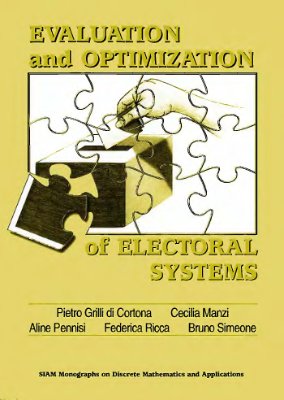Society for Industrial and Applied Mathematics, 1999, -247 pp.
The choice of an appropriate electoral system, capable of guaranteeing a representative, stable, and efficient govement, has been a major conce of the political debate in many countries in the last few years.
But how can different electoral systems be defined? What are the criteria used to determine the "quality" of an electoral system, and how can we measure them? And, again, how can we use the different criteria to design an electoral system? Moreover, how can we measure the trade-offs between conflicting criteria.
This book is the result of the contribution of experts from different fields, such as political sciences, operations research, statistics, and decision sciences. It tries to answer the questions above offering a general methodology and a set of mathematical tools, many of which are original, in order to analyze and design electoral systems.
The analysis of electoral systems is generally thought of as a matter of political and social disciplines. Nevertheless, it is possible to analyze electoral systems from a mathematical point of view. Quantitative approaches to the study of electoral systems already exist and have evolved in different directions:
an axiomatic approach, developed in Nurmi (1987) and Balinski andYoung (1982a);
a statistical approach, found in Key (1954) and in the recent Italian volume Vitali (1995);
a game theory approach, for example, in Brams (1975) and Ordeshook (1992);
a geometric approach developed in Saari (1994).
In this book we propose still another quantitative point of view: the optimization of one or many criteria.
The main steps we follow are
the decomposition of the electoral process into phases;
the definition of a general formal model for electoral systems;
the identification of qualitative criteria assessing the performance of an electoral system;
the definition of appropriate performance indicators;
the optimization of a single criterion and comparison between optimal solutions for different single criteria;
multicriteria optimization and trade-offs between criteria.
Part I develops steps 1-4, Part II investigates step 5, and Part III analyzes step 6.
I Classification and Evaluation of Electoral Systems
Four Phases of an Electoral Process
A Unified Description of Electoral Systems
Performance of an Electoral System
II Designing Electoral Systems
No Electoral System Is Perfect
Basic Properties for Electoral Formulas
Integer Optimization Approach
Rewarded and Punished Parties
Mixed Electoral Systems
III Designing Electoral Districts
Traps in Electoral District Plans
Criteria for Political Districting
Indicators for Political Districting
Optimization Models
IV the Process of Electoral Reform: A Retrospective Critical View of a Political Scientist
Difficult Crossroad
The Planning and Politics of Electoral Reform
Short Guide to the Literature
The choice of an appropriate electoral system, capable of guaranteeing a representative, stable, and efficient govement, has been a major conce of the political debate in many countries in the last few years.
But how can different electoral systems be defined? What are the criteria used to determine the "quality" of an electoral system, and how can we measure them? And, again, how can we use the different criteria to design an electoral system? Moreover, how can we measure the trade-offs between conflicting criteria.
This book is the result of the contribution of experts from different fields, such as political sciences, operations research, statistics, and decision sciences. It tries to answer the questions above offering a general methodology and a set of mathematical tools, many of which are original, in order to analyze and design electoral systems.
The analysis of electoral systems is generally thought of as a matter of political and social disciplines. Nevertheless, it is possible to analyze electoral systems from a mathematical point of view. Quantitative approaches to the study of electoral systems already exist and have evolved in different directions:
an axiomatic approach, developed in Nurmi (1987) and Balinski andYoung (1982a);
a statistical approach, found in Key (1954) and in the recent Italian volume Vitali (1995);
a game theory approach, for example, in Brams (1975) and Ordeshook (1992);
a geometric approach developed in Saari (1994).
In this book we propose still another quantitative point of view: the optimization of one or many criteria.
The main steps we follow are
the decomposition of the electoral process into phases;
the definition of a general formal model for electoral systems;
the identification of qualitative criteria assessing the performance of an electoral system;
the definition of appropriate performance indicators;
the optimization of a single criterion and comparison between optimal solutions for different single criteria;
multicriteria optimization and trade-offs between criteria.
Part I develops steps 1-4, Part II investigates step 5, and Part III analyzes step 6.
I Classification and Evaluation of Electoral Systems
Four Phases of an Electoral Process
A Unified Description of Electoral Systems
Performance of an Electoral System
II Designing Electoral Systems
No Electoral System Is Perfect
Basic Properties for Electoral Formulas
Integer Optimization Approach
Rewarded and Punished Parties
Mixed Electoral Systems
III Designing Electoral Districts
Traps in Electoral District Plans
Criteria for Political Districting
Indicators for Political Districting
Optimization Models
IV the Process of Electoral Reform: A Retrospective Critical View of a Political Scientist
Difficult Crossroad
The Planning and Politics of Electoral Reform
Short Guide to the Literature

